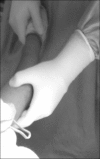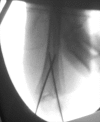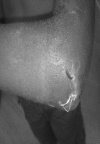A comparative study of two percutaneous pinning techniques (lateral vs medial-lateral) for Gartland type III pediatric supracondylar fracture of the humerus
- PMID: 27312248
- PMCID: PMC4999378
- DOI: 10.1007/s10195-016-0410-2
A comparative study of two percutaneous pinning techniques (lateral vs medial-lateral) for Gartland type III pediatric supracondylar fracture of the humerus
Abstract
Background: The management of displaced supracondylar fracture of the humerus with closed reduction and percutaneous pin fixation is the most widely accepted method of treatment, but controversy continues regarding the pin fixation techniques. A prospective randomized controlled study was undertaken to compare the stability, functional outcome and iatrogenic ulnar nerve injury between lateral pin fixation and medial-lateral pin fixation.
Material and method: Sixty-two patients with Gartland type III supracondylar fracture of the humerus were randomized into two groups-lateral pin fixation (n = 31) and medial-lateral pin fixation (n = 31). Primary assessment was performed for major loss of reduction and iatrogenic ulnar nerve injury. Secondary assessment included clinical outcome, elbow range of motion, radiographic measurements, Flynn grade, and complications.
Results: There were two (6.5 %) iatrogenic ulnar nerve injury cases in the medial-lateral entry group and two (6.5 %) cases with mild loss of reduction in the lateral entry group. No major loss of reduction was observed in either of the groups. There was no statistically significant difference in change of Baumann angle, metaphyseal-diaphyseal angle, Flynn grade, carrying angle, and the total elbow range of motion (P < 0.05) between the two groups.
Conclusions: Lateral pin fixation offers similar functional and radiological outcome and almost equal mechanical stability compared with medial-lateral pinning without the risk of iatrogenic ulnar nerve injury. LEVEL OF EVIDENCE [OCEBM 2011]: Level 2.
Keywords: Humerus; Iatrogenic ulnar nerve injury; Percutaneous fixation; Randomized controlled study; Supracondylar fracture.
Conflict of interest statement
The authors declare that they have no conflict of interest. (1) All patients provided informed consent prior being included into the study. (2) All procedures involving human participants were in accordance with the 1964 Helsinki Declaration and its later amendments. (3) The study was approved by the Research Ethics Committee.
Figures
References
-
- Beaty JH, Kasser JR. Fractures about the elbow. Instr Course Lect. 1995;44:199–215. - PubMed
-
- Kocher MS, Kasser JR, Waters PM, Bae D, Snyder BD, Hresko MT, et al. Lateral entry compared with medial and lateral entry pin fixation for completely displaced supracondylar humeral fractures in children. A randomized clinical trial. J Bone Jt Surg Am. 2007;89(4):706–712. doi: 10.2106/JBJS.F.00379. - DOI - PubMed
-
- Gordon JE, Patton CM, Luhmann SJ, Bassett GS, Schoenecker PL. Fracture stability after pinning of displaced supracondylar distal humerus fractures in children. J Pediatr Orthop. 2001;21(3):313–318. - PubMed
Publication types
MeSH terms
LinkOut - more resources
Full Text Sources
Other Literature Sources
Medical
Research Materials





